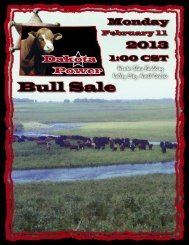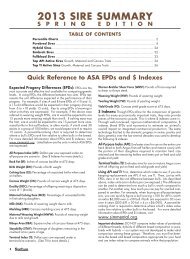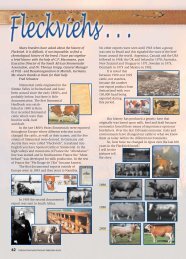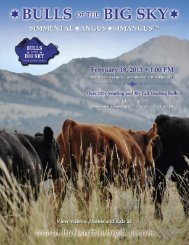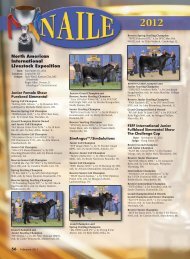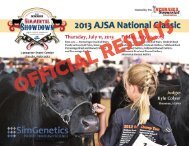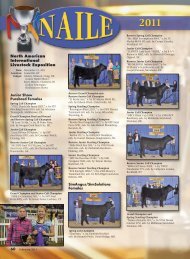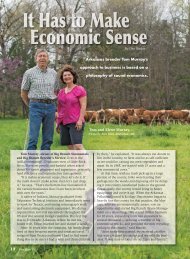prickly pear simmental ranch - American Simmental Association
prickly pear simmental ranch - American Simmental Association
prickly pear simmental ranch - American Simmental Association
You also want an ePaper? Increase the reach of your titles
YUMPU automatically turns print PDFs into web optimized ePapers that Google loves.
SUGGESTED MANAGEMENT GUIDELINES FOR YEARLING BULLS<br />
We are believers in the use of yearling bulls and feel it is one of the best years of their lives. It’s a time<br />
when the bulls are easy to manage and their only concern is breeding cows. We have found that yearling<br />
bulls that are managed carefully during the second year of their lives not only do well, but they will also<br />
perform better over time.<br />
Below are some suggested guidelines for the care of yearling bulls:<br />
1. Upon delivery to your <strong>ranch</strong>, keep yearling bulls separate from older bulls. Feed the yearling bulls a<br />
maintenance ration of 5-8 lbs. per head of grain and free choice hay. Reduce grain feed gradually so<br />
they are on straight hay or grass 2-4 weeks prior to breeding season.<br />
2. When possible, try to limit the bulls to 45-60 days of pasture service the first year. At this time, or as<br />
soon as possible, remove the bulls to put them in separate pastures with plenty of good, quality grass.<br />
3. It is best to feed yearling bulls separate from older bulls until after their second breeding season. This<br />
allowes them to achieve the growth and strength necessary to compete with older bulls for feed and space.<br />
You will see the benefits of a litttle added cost and care of feeding a yearling bull by probably two or<br />
three more years of service from a well managed and healthy bull.<br />
QUICK GUIDE TO ASA EPDs AND $ INDEXES<br />
Expected Progeny Differences (EPDs): EPDs are the most accurate and<br />
effective tool available for comparing genetic levels. In using EPDs, the difference<br />
between two sires’ EPDs represents the unit difference expected in the<br />
performance of their progeny. For example, if sires A and B have EPDs of<br />
+10 and –5, a 15-unit difference would be expected in their progeny (moving<br />
from -5 to +10 yields 15 units). Key to using EPDs is knowing what units<br />
they are expressed in. For example, if the above case referred to weaning<br />
weight EPDs, A would be expected to sire 15-pounds more weaning weight<br />
than B. If calving ease were the trait, A would be expected to sire 15-percent<br />
more unassisted births in first-calf heifers; in other words, if B sired 30 assists<br />
in a group of 100 heifers, we’d expect A to require 15 assists. A percentile-ranking<br />
chart is required to determine where a bull’s EPDs rank him<br />
relative to other bulls in the breed. For percentile rankings or more detailed<br />
information about EPDs and $ indexes visit www.<strong>simmental</strong>.org. Listed below<br />
are the units ASA EPDs are expressed in:<br />
All-Purpose Index (API): Dollars per cow exposed under an all-purposesire<br />
scenario. (See below for more details.)<br />
Back Fat (BF): Inches of backfat.<br />
Birth Weight (BW): Pounds of birth weight.<br />
Calving Ease (CE): Percent of unassisted births when used on heifers.<br />
Carcass Weight (CW): Pounds of carcass weight.<br />
Maternal Calving Ease (MCE): Percent of unassisted births in first-calving<br />
daughters.<br />
Milk (MLK): Pounds of weaning weight due to milk.<br />
Marbling (MRB): Marbling score.<br />
Maternal Weaning Weight (MWW): Pounds of weaning weight due to milk<br />
and growth.<br />
Ribeye Area (REA): Square inches of ribeye.<br />
Warner-Bratzler Shear Force (WBSF): Pounds of force required to shear<br />
a steak.<br />
Stayability (STAY): Percent of daughters remaining in the cowherd at 6<br />
years of age.<br />
Terminal Index (TI): Dollars per cow exposed under a terminal-sire scenario.<br />
(See below for more details.)<br />
Weaning Weight (WW): Pounds of weaning weight.<br />
Yearling Weight (YW): Pounds of yearling weight.<br />
Yield Grade (YG): Yield grade score.<br />
$ Indexes: Though EPDs allow for the comparison of genetic levels for many<br />
economically important traits, they only provide a piece of the economic puzzle.<br />
That’s where $ indexes come in. Through well-conceived, rigorous<br />
mathematical computation, $ indexes blend EPDs and economics to estimate<br />
an animal’s overall impact on your bottom line. The same technology that led<br />
to the dramatic progress in swine, poultry and dairy genetics over the last several<br />
decades was used to develop the following $ indexes:<br />
All-Purpose Index (API): Evaluates sires for use on the entire cow herd<br />
(bred to both Angus first-calf heifers and mature cows) with the portion of<br />
their daughters required to maintain herd size retained and the remaining<br />
heifers and steers put on feed and sold grade and yield.<br />
Terminal Index (TI): Evaluates sire for use on mature Angus cows with all<br />
offspring put on feed and sold grade and yield.<br />
Using API and TI: First, determine which index to use; if you’re keeping replacements<br />
use API, if not, TI. Then, just as with EPDs, zero in on the unit difference<br />
between bulls. (As described above, index units are in dollars per cow<br />
exposed.) The difference can be used to determine how much a bull is worth<br />
compared to another. Or, put another way, how much you can pay for one bull<br />
compared to another. For example, when buying an all-purpose-type sire, you<br />
can quickly figure a bull scoring +100 for API is worth an extra $6,000 over<br />
a+50 bull if both are exposed to 30 cows over 4 years ($50 diff. x 30 hd. x 4<br />
yr. = $6,000). A percentile-ranking chart is required to determine where a<br />
bull’s index value ranks him relative to other bulls in the breed. For percentile<br />
rankings or more detailed information about EPDs and $ indexes.<br />
4




